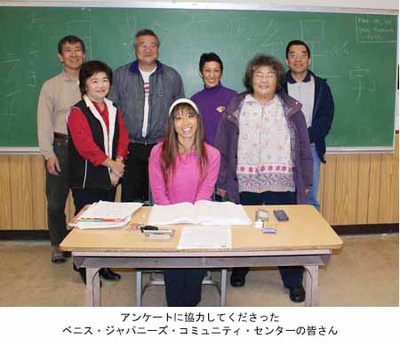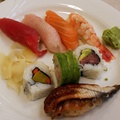"This book is good"
Kay Garvin (Kaori Kawakami Garvin) wrote the following in large letters on the blackboard. It was all in hiragana. On this day, she was teaching tag questions.
"Not good at all"
Write the answers on the board.
"It means 100% No," Kei explains in English, to which the students respond in Japanese with a request: "Explain it again!"
This is the Venice Japanese Community Center of WLA (12448 Braddock Drive, LA CA 90066: tel 310-822-8885). A Japanese teacher, Kei-san, teaches Japanese every Friday. Adults in their 40s and 50s gather to learn Japanese after finishing their day jobs. Most are Japanese-Americans, but white people are also often seen. They are people who became interested in Japan through martial arts, or people whose spouses or partners are Japanese. The center also holds Japanese language classes for children on Saturdays.
"What does this word dirty mean?" asks Kay.
One student answered in a small voice,
"That's right too!" Kay praised loudly.
The answer may have been wrong in Saturday's class, but it was grammatically correct. Above all, Kay was happy that the students had managed to come up with an answer.
This Japanese language class for adults started in 2000. According to Kei, the first class was so crowded with students that the classroom overflowed. The number of students gradually decreased, and now about 10 people come and go every week. Since the length of time each person takes to study varies, there is no curriculum like in normal schools where students are told to complete a certain amount of material in a year. The pace is "as slow as a turtle's steps" (Kei). Some of the students watch the Japanese language channel every week, and say that thanks to this class, their listening skills have improved.
Many parents of Japanese children living in Los Angeles send their children to Japanese language schools on Saturdays, even though they attend local schools. Japanese language schools are also held at temples, churches, Japanese cultural centers, and private educational institutions, and there are about 15 schools listed on the website of the Japanese Consulate General in Los Angeles ( http://www.la.us.emb-japan.go.jp/web/m04_01_04.htm ). Recently, non-Japanese children who are familiar with anime have also been attending Japanese language schools, but most of the children are Japanese children who have been sent there to become familiar with the Japanese language. Even if the children attend classes once a week for a few hours, if the parents use Japanese at home and the children have the ability to absorb the language, it seems that their Japanese will improve considerably (although reading and writing seems to be difficult).
On the other hand, there are not as many Japanese language classes for adults as there are for children, and the only ones that are open year-round are the Japanese Community Centers in Venice, Gardena, Hollywood, and East San Gabriel Valley. So why do Japanese-American adults study Japanese? In the second part of this article, we conducted a survey with the cooperation of the Japanese language class staff in Venice, asking them, "Why do you study Japanese?"
© 2009 Yumiko Hashimoto











